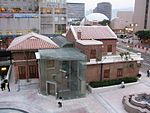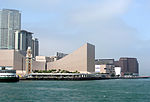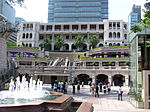Kowloon railway station (KCR)
1909 establishments in Hong Kong1974 disestablishments in Hong KongDefunct railway stations in Hong KongEngvarB from September 2013Former Kowloon–Canton Railway stations ... and 5 more
Former buildings and structures in Hong KongMonuments and memorials in Hong KongRailway stations closed in 1974Railway stations in Hong Kong opened in 1909Tsim Sha Tsui

Kowloon station (Chinese: 九龍車站), colliquially Old Tsim Sha Tsui Terminal, located in Tsim Sha Tsui on the present site of the Hong Kong Cultural Centre, was the former southern terminus of the Kowloon–Canton Railway (KCR).
Excerpt from the Wikipedia article Kowloon railway station (KCR) (License: CC BY-SA 3.0, Authors, Images).Kowloon railway station (KCR)
Salisbury Road, Kowloon Tsim Sha Tsui (Yau Tsim Mong District)
Geographical coordinates (GPS) Address Phone number Website Nearby Places Show on map
Geographical coordinates (GPS)
| Latitude | Longitude |
|---|---|
| N 22.293888888889 ° | E 114.17027777778 ° |
Address
香港文化中心 Hong Kong Cultural Centre
Salisbury Road
Kowloon, Tsim Sha Tsui (Yau Tsim Mong District)
Hong Kong, China
Open on Google Maps











